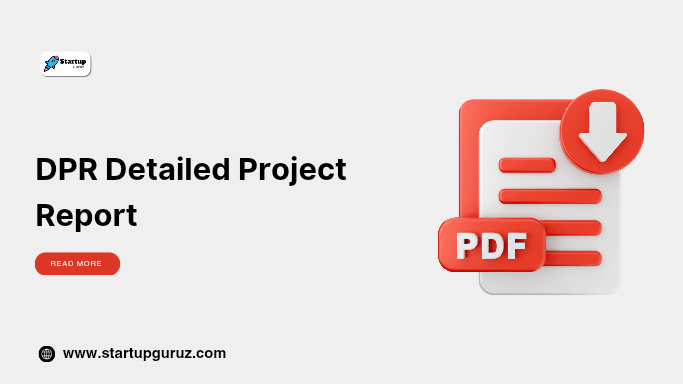DPR Detailed Project Report
Comprehensive Guide to Detailed Project Report (DPR)
A Detailed Project Report (DPR) is a critical document that outlines the technical, financial, and operational aspects of a project. It acts as a blueprint, enabling stakeholders to assess the feasibility and sustainability of a proposed venture. Whether you are planning to start a new business, expand an existing one, or seek funding, a DPR is essential. This guide provides a comprehensive overview of the importance, structure, and process of preparing a DPR, along with answers to frequently asked questions.

What is a Detailed Project Report (DPR)?
A Detailed Project Report (DPR) is an exhaustive document that provides a thorough analysis of all aspects of a project. It includes technical specifications, market analysis, cost estimation, financial projections, and risk assessments.
It is commonly used for:
- Business loans or funding proposals.
- Infrastructure or large-scale projects.
- Government scheme applications.
- Monitoring and evaluation of ongoing projects.
Importance of a Detailed Project Report
- Feasibility Analysis: Assesses technical, economic, and financial viability.
- Risk Assessment: Identifies potential risks and mitigation strategies.
- Attracting Investors: Builds confidence among investors by demonstrating a structured plan.
- Compliance: Ensures the project meets legal and regulatory requirements.
- Resource Planning: Outlines the resources required, including manpower, equipment, and raw materials.
Key Components of a DPR
1. Executive Summary
- Overview of the project.
- Objectives and scope.
- Key highlights of the financial and operational plan.
2. Project Background
- Project history or concept.
- Stakeholders involved.
- Need or rationale for the project.
3. Market Analysis
- Industry trends and growth potential.
- Target market and audience segmentation.
- Competitive landscape.
4. Technical Details
- Technology to be used.
- Location and infrastructure requirements.
- Machinery, tools, or software specifications.
5. Financial Plan
- Total project cost (capital expenditure and operational costs).
- Funding sources (equity, loans, subsidies).
- Revenue projections and break-even analysis.
- Profit and loss statement and balance sheet.
6. Risk Analysis
- SWOT analysis (Strengths, Weaknesses, Opportunities, Threats).
- Identification of potential risks.
- Contingency plans.
7. Implementation Plan
- Timeline and milestones.
- Roles and responsibilities of stakeholders.
- Monitoring and evaluation mechanisms.
8. Legal and Regulatory Compliance
- Required permits and licenses.
- Environmental impact assessments.
- Adherence to local, state, and national regulations.
9. Conclusion and Recommendations
- Summary of findings.
- Recommendations for project execution.
10. Annexures
- Supporting documents like quotations, feasibility studies, and agreements.
Steps to Prepare a Detailed Project Report (DPR)
Step 1: Understand the Purpose
Define the objective of the DPR—whether for internal planning, funding, or compliance.
Step 2: Conduct Research
Gather information on market trends, technical requirements, and financial projections.
Step 3: Use a Standard Format
Follow a structured format to ensure clarity and comprehensiveness.
Step 4: Provide Accurate Financial Details
Include detailed calculations for costs, revenue, and profitability.
Step 5: Review and Finalize
Proofread the document to ensure accuracy and consistency.
Common Mistakes to Avoid in DPR Preparation
- Incomplete Information: Missing critical details like market analysis or financial projections.
- Overestimating Revenue: Unrealistic assumptions can lead to credibility issues.
- Ignoring Risks: Failing to identify and address risks can derail the project.
- Poor Presentation: A cluttered or unorganized report can confuse stakeholders.
FAQs on Detailed Project Report (DPR)
1. What is the purpose of a DPR?
A DPR provides a comprehensive overview of a project, enabling stakeholders to assess its feasibility, viability, and sustainability.
2. Who prepares a DPR?
It is usually prepared by project managers, consultants, or experts in the relevant field.
3. Is a DPR mandatory for loans?
Yes, most financial institutions require a DPR to evaluate the viability of a project before approving a loan.
4. Can I prepare a DPR myself?
Yes, but it is advisable to seek professional help to ensure accuracy and compliance with guidelines.
5. What is the ideal length of a DPR?
There is no fixed length, but it should be comprehensive yet concise, covering all essential aspects.
6. How much does it cost to prepare a DPR?
The cost varies depending on the project’s complexity and the consultant’s expertise, ranging from ₹10,000 to ₹1,00,000 or more.
7. What are the common formats for a DPR?
Standard formats are often provided by banks, government agencies, or industry bodies.
8. How do I ensure my DPR meets legal requirements?
Consult with legal experts and adhere to relevant regulations and guidelines.
9. Can a DPR be updated after submission?
Yes, you can revise it based on feedback from stakeholders or changing project conditions.
10. What is the difference between a DPR and a business plan?
A DPR is more detailed and technical, while a business plan is focused on strategy and marketing.